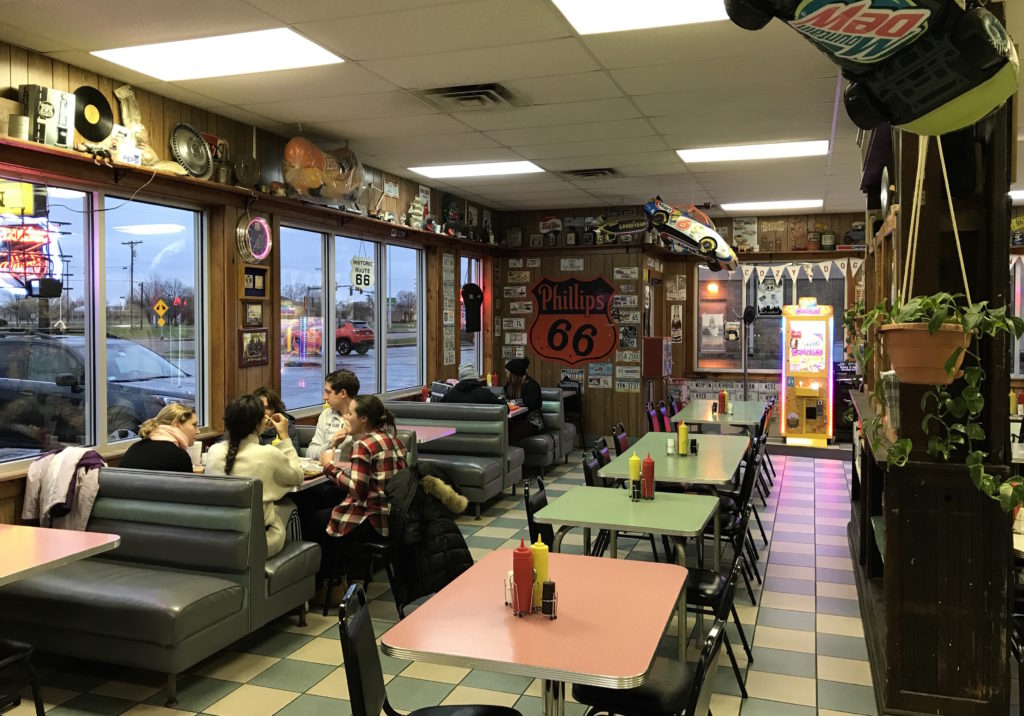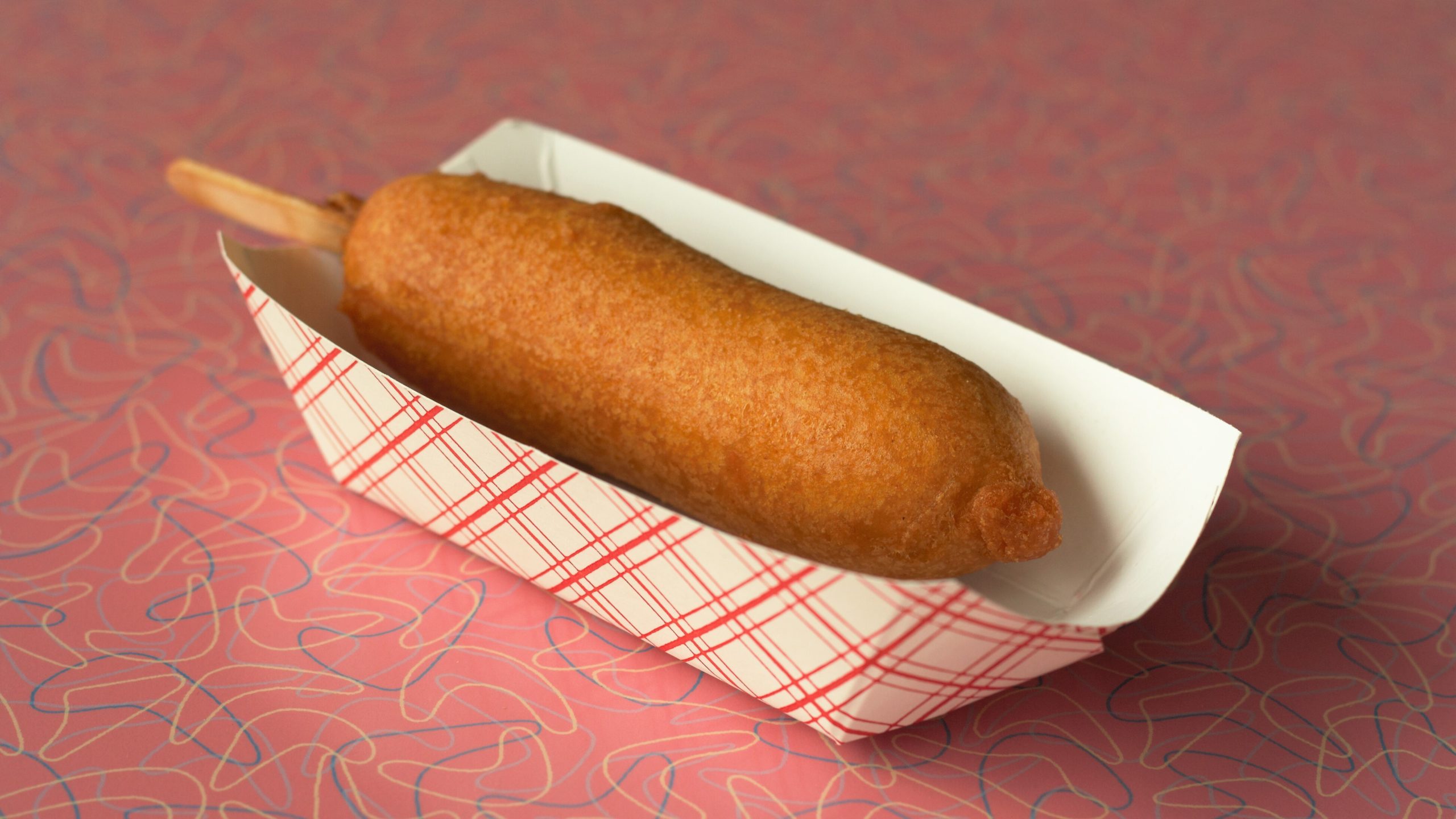There are many fine restaurants in Springfield. Saputo’s, the Italian bistro where former House Speaker Michael Madigan dined every evening at precisely 7 p.m., always sitting at the same table and drinking the same wine. Loukinens’ on 4th, where you can always be sure to spot legislators and lobbyists cutting deals over pan-seared Chilean Sea Bass. The last time I visited our state capital, though, I only wanted to eat at the Cozy Dog Drive In, the home of Illinois’s most important culinary innovation, the corn dog.
Illinois has a state snack food (popcorn), a state vegetable (sweet corn), and a state grain (corn). If the state had a hand-held meal, it would be the corn dog. The corn dog is Illinois on a stick: a hot dog, representing Chicago’s meatpacking heritage, wrapped in a cornmeal shell, representing the crop that carpeted over the prairie. Illinois grows 1.8 billion bushels of corn a year, second only to Iowa.
Surprisingly little of that corn goes into making corn dogs, though. Corn dogs are ubiquitous at the State Fair, sold at every other food stand on the midway, along with Lemon Shake-Ups. Every summer, the American stomach emits an enzyme enabling it to digest foods that would be inedible the rest of the year. The corn dog has, mostly, been relegated to the “fair food” category, along with funnel cakes, elephant ears, blooming onions, and chocolate-covered bacon. It’s not easy to find a corn dog in a restaurant, even in hot-dog crazy Chicago.
In 2018, the Tribune’s Nick Kindeslperger lamented that “if you want a corn dog, that battered and fried dish you eat on a stick, you’ll have to put in some real effort, and what you get might not be worth it…. As recently as six years ago, my current Tribune colleague, Louisa Chu, enthused on WBEZ about a “corn dog renaissance” in Chicago. But most of the restaurants either closed (Franks ‘n’ Dawgs, Wiener and Still Champion) or removed the corn dogs from their menus (Bangers and Lace, Old Town Social), leaving a handheld-fried-food hole in our scene.”
After much searching, I located a corn dog at Wolfy’s, 2734 W. Peterson Ave., in West Rogers Park. However, it was a minor offering on a hot-dog heavy menu—undersized, and not especially crunchy. If I wanted a real Illinois corn dog, I was going to have to go to the source. That’s how I ended up at Cozy Dog. A kitschy diner founded in 1946, Cozy Dog advertises itself with an illuminated sign depicting two hot dogs in connubial bliss. Appropriately enough for a purveyor of an all-American meal, it’s located in a strip mall on Route 66, and sells highway memorabilia along with hot dogs.
Cozy Dog bills itself as the “Birthplace of the Corn Dog,” with a poster depicting a nurse feeding mustard to a baby corn dog. According to a handwritten history on the restaurant’s wall, though, Cozy Dog founder Ed Waldmire actually discovered the concept “at a roadside cafe in Muskogee, Oklahoma,” while driving from his hometown of Springfield to the army air base where he was stationed in Amarillo, Texas. Ed ordered “a row of 3 wieners laid down in a hot iron, covered with a batter, & closed up to cook.”

That was certainly around when the delicacy took off. Proto-corn-dog molds emerged in the patent records in 1910, but for baking, not frying. (There’s your problem.) The act of consuming fried corn dogs really entered the historical record in the 1940s, in Florida, Oregon, Texas, Minnesota. A May 1940 ad for the Silver Dollar Restaurant, north of Ada, Oklahoma, described its corn dog as the “Sandwich Sensation Now—Different” and “Worth Driving Miles For.” (Ada’s just a couple hours from Muskogee.) Minnesota’s famous Pronto Pup was trademarked in 1942 — a Tribune writer described it in 1946 as the “postwar version of the hot dog.” Corn dogs were in the air.
Ed loved the corn-coated wieners, but thought the cooking time was too long for a short-order restaurant. When he returned home to Springfield after his discharge, he began tinkering with “a rack that would clamp a flat stick. The impaled weiner could then be dipped & coated in batter, then the rack (ultimately designed to clamp 3 “dogs”) set into a fryer — with the dogs submerged just up to the base of the stick.”
Thanks to that technological innovation, Ed could sell corn dogs as fast as he could fry ’em. After years of wartime rationing, they were a huge hit with a public “dying to try something new,” Ed told the State Journal-Register. “You could have sold anything then. And Cozy Dogs— at first we called them Crusty Curs—were the biggest thing to hit the State Fair then. We couldn’t make them fast enough.”
The name change helped secure the corn dog’s position in Illinoisana. Crusty Cur sounds like a seedy waterfront tavern, Cozy Dog a homey restaurant. Even after 70 years of success, Cozy Dog is almost pretentiously unpretentious. The menu is spelled out with plastic letters affixed to a grooved board, as at all real hot dog stands. A Cozy Dog is $2.25, a bargain even Downstate. I ordered one and took it to a booth by the window, with packets of mustard. In Illinois, we don’t even put ketchup on corn dogs.
The thrill of a corn dog is the gustatory contrast between the shell and the reward at the center. I bit into the crispy cornmeal batter, tasting a cereal sweetness, and then my teeth found the soft hot dog. I can’t say “juicy.” It wasn’t the plumpest, most succulent hot dog, but it didn’t need to be, since it was only doing half the work. As the meat and the meal mingled in my mouth, I struggled to come up with a word that described the combination of two so very different foods, impaled together on the same stick. I could only think of one.
It tasted like Illinois.




Comments are closed.